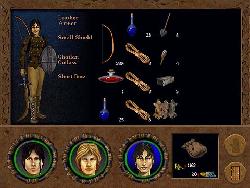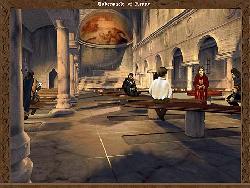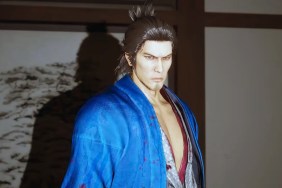Onwards, young fella!
Welcome to Antara, a world of Kings and cowherds. A place rife with conflict and intrigue, called home by many adventurers. In this land even lowly, young fisherman can realize greatness through their heroic deeds and noble sentiments. The tale set before us is of one such fellow who, born the son of a mere innkeeper, has the potential to carve his name into history by following the calling of his nature, by following the power of Magic!! This man is Aren. Aiding him on his quest is the young noble William, of the House Escobar, who fast became Aren’s friend after Aren saved his life with the help of magic. William, seeing the apparent potential in Aren’s abilities, inspired him to seek help from a proper Magician, specifically the Mage of House Escobar, who could be found in their home city of Panizo. Thus does their journey begin, but little do they know that their destinies hold adventures more intriguing and exciting than they can ever suspect. Their story is now to be written, and you are it’s author.
Betrayal at Antara
is a ‘spiritual’ sequel to Sierra’s past hit Betrayal at Krondor. This
basically means that while the story world and it’s characters are entirely
different, the game engine and it’s play mechanics are the same, although slightly
improved, since this is the second time around.
Betrayal at Antara is an RPG. Navigation through the game world is
accomplished through a first person perspective engine, similar yet highly inferior
to that used in Daggerfall. The characters move
around in a series of “steps”, ranging from Short to Long. This provides an
effect reminiscent to playing Quake on a 286; however, it gets the job done.
The world in view is lushly represented with fine high-resolution artwork portraying
dark forests as well as small villages and cities. The only problem is that
the artists chose to do this with sprites, instead of proper three dimensional
models, seriously deteriorating the overall graphical effect.
Once combat initiates, however, the view changes. The game takes on a third
person isometric perspective, much like the view style used in games like Diablo,
however in this case the effect is more like viewing a chessboard. The turn-based
nature of battle further extends this analogy. Characters can either change
position, attack with weapons in a variety of ways, cast spells, consume potions
or just run like hell during a turn. The battle thus alternates turns till one
side is defeated or escapes. This sort of tactical, turn-based combat system
is quite a departure from the now common style of first-person combat first
pioneered in Eye of the Beholder and such RPG’s. Personally, I prefer
this sort of style as it allows the player time to develop sound combat strategy
that may allow even a weak and tired party to come out winners against the odds.
It’s also less irritating than the real-time combat in games like Daggerfall
which gets tiresome after a while. The engine is extremely effective in achieving
it’s end without being complicated or archaic in the least and still makes for
well paced and entertaining combat.
 Magic, an important part of
Magic, an important part of
the combat in the game is also managed quite well. The wizard of the party is
able to create spells by combining various skills that he has picked up along
the way. Skills can be acquired in the usual methods of research or by observing
these skills in action during combat. Thus even the most vicious encounters
with the most powerful mages can have advantageous effects even in a losing
situation. This magical system is especially preferable as it takes away some
of the routine of exploring game worlds in search of “hidden” spells or having
to gain X experience points to be able to learn specific spells. This common
sense magic system allows for a more natural increase in the character’s skills
more akin to reality rather than accounting with experience points.
Thus armed with easy yet effective combat and magic systems, the two fellows set forth on their mighty quest only to encounter…People! Yes, even the greatest adventurer in history has had to talk to people, if only to ask for directions. The two friends continue this fine tradition as they move from town to town gathering more and more information about the world around them and in turn acquiring quests. My only question to the game designers is, since when did people look like 2D card board cut-outs to you? During conversations, the view mode switches from the first person and shows the player a single static image of the speaker as it presents you with your dialogue options. While this system worked fine a few years ago, modern animation techniques make this system old and slightly annoying, as it removes some of the immersive aspects of the game.
While Betrayal in Antara slightly improves the fine mechanics of the Betrayal at Krondor engine, it still relies too heavily on some of the old engine’s methods, which have seriously begun to show their age and which will not be able to stand against the slew of revolutionary RPG’s that are slated to hit the market soon. The game has a lot of substance storywise, it’s just that it’s way too much of a rehash with very little innovative improvements over the old. This game would rest well in the hands of a player new to the game engine, and for those who loved Krondor for it. The rest should look ahead to the future and leave this old engine behind.
-
Good Plot
-
Cool Magic system
-
3D models would have helped
-
Old engine updated but outdated











